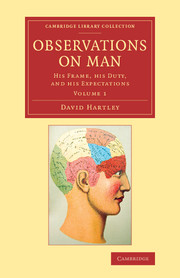
-
Select format
-
- Publisher:
- Cambridge University Press
- Publication date:
- October 2014
- October 2013
- ISBN:
- 9781139628617
- 9781108063623
- Dimensions:
- Weight & Pages:
- Dimensions:
- (216 x 140 mm)
- Weight & Pages:
- 0.68kg, 538 Pages
You may already have access via personal or institutional login
Book description
The orphaned son of an Anglican clergyman, David Hartley (1705–57) was originally destined for holy orders. Declining to subscribe to the Thirty-Nine Articles, he turned to medicine and science yet remained a religious believer. This, his most significant work, provides a rigorous analysis of human nature, blending philosophy, psychology and theology. First published in two volumes in 1749, Observations on Man is notable for being based on the doctrine of the association of ideas. It greatly influenced scientists, theologians, social reformers and poets: Samuel Taylor Coleridge, who named his eldest son after Hartley, had his portrait painted while holding a copy. In Volume 1, Hartley utilises Newtonian science in his observations. He presents a theory of 'vibrations', explaining how the elements of the nerves and brain interact as a result of stimulation, creating 'associations' and emotions.
Contents
Metrics
Full text views
Full text views help Loading metrics...
Loading metrics...
* Views captured on Cambridge Core between #date#. This data will be updated every 24 hours.
Usage data cannot currently be displayed.
Accessibility standard: Unknown
Why this information is here
This section outlines the accessibility features of this content - including support for screen readers, full keyboard navigation and high-contrast display options. This may not be relevant for you.
Accessibility Information
Accessibility compliance for the PDF of this book is currently unknown and may be updated in the future.


